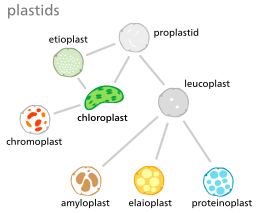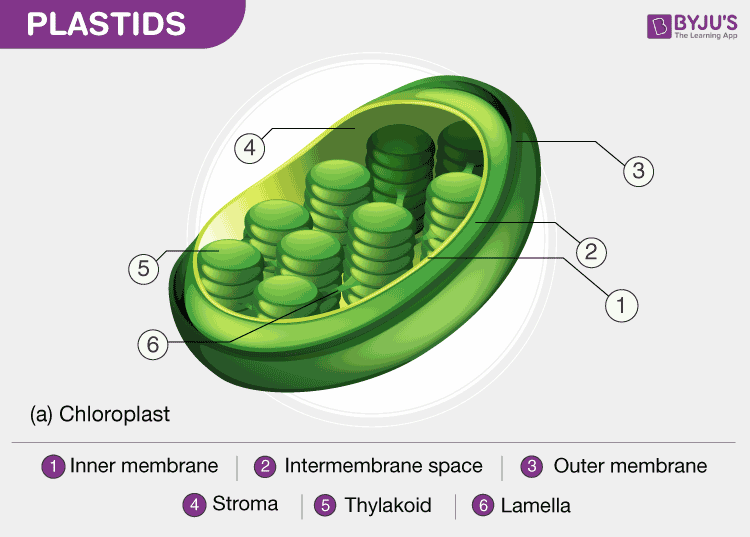These are double-membrane organelles that contain pigments helpful in Photosynthesis and also govern the change in the colours of the cells. They help in maintaining balance.

Plastids Definition Types Main Structure And Function
The pigment present in them is carotene which gives a different colour to fruits and flowers.

. Answer 1 of 19. Chloroplasts are found mainly in the cells of the leaves of higher plants and algae. For class 9 - 17763507.
The types of plastids are-. Plastids develop from colorless precursors called pro-plastids. There are different types of plastids with their specialized functions.
I Leucoplasts- Colourless plastids. These are yellow or brown plastids found in brown algae diatoms and dinoflagellates. Ii Chromoplasts Coloured plastids other than green iii Chloroplasts- Green plastids.
Formed molded plural plastids is a major double-membrane organelle found in the cells of plants algae and some other eukaryotic organisms. In their roles the different types of plastids contribute to plant metabolism thus promoting plant growth and development. 1 Chloroplasts- are the green plastids which contain chlorophyll pigments for photosynthesis.
It is the most biologically important plastid. Functions of Chloroplast or plastid All plant cells contain plastids in some shape or form. With the exception of some protistans eg Euglena dinophyceae diatoms plastids are restricted to plants only.
The leucoplasts are the colourless plastids principally serving the purpose of storage. Functions of Plastids. There are different types of plastids with their specialized functions.
Plastids are found in the cells of plants and algae that are responsible for manufacturing and storing food. The chlorophyll pigment is the most significant and essential pigments as it plays a vital role in the biological process of photosynthesis. They trap solar energy to manufacture food through the process of photosynthesis.
Double membrane-bound organelles found in plants. They provide colour to fruits and flowers. Plastids are semi-autonomous organelles having DNA and double membrane envelope which store or synthesise various types of organic compounds.
Formed molded plural plastids is a membrane-bound organelle found in the cells of plants algae and some other eukaryotic organisms. Plastids were discovered and named by Ernst Haeckel but A. Plastids are double-membrane organelles that are found in the cells of plants and algae.
What are plastids. Types of Plastids in Cell. Responsible for photosynthesis.
They are considered to be intracellular endosymbiotic cyanobacteriaExamples include chloroplasts used for photosynthesis chromoplasts used for pigment synthesis and storage and leucoplasts. In their roles the different types of plastids contribute to plant metabolism thus promoting plant growth and development. One of the main characteristics of these organelles is the fact that they have a double membrane.
By the process of photosynthesis they produce oxygen and the most of the chemical energy used by living organisms. All the three types of plastids can change one form into another. Among them a few are mainly classified based on the presence or absence of the Biological pigments and their stages of development.
Schimper was the first to grant them a clear definition. Plastids are a group of phylogenetically and physiologically-related organelles found in all types of plants and algae. Further all plastids have a common.
These often contain pigments that are used in photosynthesis and different types of pigments that can change the colour of the cell. Plastids may be coloured or colourless and are of three types. In their roles the different types of plastids contribute to plant metabolism thus promoting plant growth and development.
Chromoplasts are carotenoid pigments that allow different colours to be seen in leaves and fruits. One of the main characteristics of these organelles is the fact that they have a double membrane. Plastids are responsible for the manufacturing and storing of food.
One host cell can contain several types of plastids. Leucoplasts These are colorless non-pigmented plastids found in the non-photosynthetic parts of the plant such as the roots. Chloroplasts usually convert into chromoplasts.
The green plastids or chloroplastids. Process by which plants breathe eat and drink. Chromoplasts It refers to an area for all the pigments to be kept and synthesized in the plant.
Among them a few are mainly classified based on the presence or absence of the Biological. Plastid is a membrane-bound organelle found in. Plastids types and functions.
On the basis of nature of storage compound leucoplastids are amyloplasts starch elaioplasts oil or aleuroplasts protein. They are variously shaped viz oval rod like or filamentous. The types of plastids are- 1 Chloroplasts- are the green plastids which contain chlorophyll pigments for photosynthesis.
These often contain pigments that are used in photosynthesis and different types of pigments that can change the colour of the cell. 3 Gerontoplasts- are the chloroplasts that are. Chloroplasts are biconvex shaped semi-porous double membraned cell organelle found within the mesophyll.
The different types of chlorophyll pigments are. On the basis of types of pigments they contain Schimper 1883 classified them in three types. Based on these pigments in a plant cell plastids are divided into four parts Chloroplasts are double membraned an oval-shaped organelle that is found in the mesophyll cells it is a type of ground tissue which is found in leaves of the plant or the epidermal cells of the plants they are less developed and are smaller in size as compared.
Chloroplasts Chloroplasts are the most known plastids and are responsible for photosynthesis. These often contain pigments that are used in photosynthesis and different types of pigments that can change the colour of the cell. Plastids are remnants of a photosynthetic.
2 Chromoplasts- are the coloured plastids for pigment synthesis and storage. They helps in storage of proteins starch and oil. There are different types of chlorophyll pigments and are classified mainly based on their structure functions and other features.
The plastid is a semi-autonomous self-reproducing organelle. Write two types of plastids along with their function. Plastids are double-membrane organelles which are found in the cells of plants and algae.

Plastids Different Types Of Plastids And Their Functions In Plants Cell

Plastids Different Types Of Plastids And Their Functions In Plants Cell

Plastids Definition Structure Types Functions Video Lesson Transcript Study Com

0 Comments